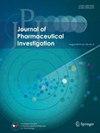无定形鼻粉的先进性能:体外/离体研究及与体内药代动力学的相关性
IF 5.1
4区 医学
Q1 PHARMACOLOGY & PHARMACY
引用次数: 1
摘要
摘要:目的非晶态固体分散体(ASD)用于鼻腔给药提供了增加药物释放性能的机会,同时使用具有黏附特性的聚合物。本研究的目的是将这种溶解度增强技术应用于一种难溶性药物的鼻腔给药,同时比较两种颗粒工程策略,即喷雾干燥微颗粒和嵌合团块,以及相应的晶体药物物理共混物。方法采用不同的聚合物和颗粒工程技术制备吡罗昔康制剂,并通过体外释放、体外渗透、鼻沉积和体内药动学研究对其进行评价。结果羟丙基甲基纤维素(HPMC)与聚乙烯吡罗烷酮/醋酸乙烯共混物相比,ASD的药物释放和渗透能力增强。HPMC嵌合团块的鼻沉积提示脱靶沉积。体内药代动力学研究表明,喷雾干燥含hpmc的微颗粒具有最高的最大血浆浓度(cmax)和最低的达到时间(tmax)。体外释放率与体内吸收率、最大吸收率与体外性能呈正相关。在排除鼻腔靶向沉积最少的制剂后,药物的体外释放和体外渗透性能也与0 ~ 1 h的cmax和药物浓度-时间曲线下面积(AUC)相关,r2和gt;0.89. 结论ASD鼻腔给药具有快速的药物吸收作用,这取决于所采用的聚合物的过饱和能力。体内外相关性表明,体外释放和体外渗透研究是预测鼻吸收的工具。本文章由计算机程序翻译,如有差异,请以英文原文为准。
Amorphous nasal powder advanced performance: in vitro/ex vivo studies and correlation with in vivo pharmacokinetics
Abstract Purpose Amorphous solid dispersions (ASD) for nasal delivery offer the opportunity to increase drug release performance, while using polymers with mucoadhesive properties. The aim of the present study was to apply this solubility enhancement technique to a poorly soluble drug for nasal delivery, while comparing two particle engineering strategies, namely spray dried microparticles and chimeral agglomerates, with the corresponding physical blends with crystalline drug. Methods Formulations of piroxicam were manufactured using varied polymer and particle engineering strategies and evaluated through in vitro drug release and ex vivo permeation studies, as well as nasal deposition and in vivo pharmacokinetic studies. Results ASD with hydroxypropyl methylcellulose (HPMC) showed enhanced drug release and permeation, compared to polyvinylpyrrolidone/vinyl acetate formulations and blends. Nasal deposition of HPMC chimeral agglomerates suggested off-target deposition. In vivo pharmacokinetic studies revealed that spray-dried HPMC-containing microparticles exhibited the highest maximum plasma concentration (C max ) and the lowest time to attain it (t max ). In vitro release rate and in vivo absorption rate were correlated as well as t max and in vitro performance. When excluding the formulation with least nasal targeted deposition, in vitro release and ex vivo permeation performance were also correlated with C max and area under the drug concentration-time curve (AUC) from 0 to 1 h, with R 2 > 0.89. Conclusion ASD for nasal delivery provide fast drug absorption, which depends on the supersaturation ability of the polymer employed. In vitro-in vivo correlations suggested that in vitro release and ex vivo permeation studies are predictive tools regarding nasal absorption.
求助全文
通过发布文献求助,成功后即可免费获取论文全文。
去求助
来源期刊

Journal of Pharmaceutical Investigation
Pharmacology, Toxicology and Pharmaceutics-Pharmaceutical Science
CiteScore
10.20
自引率
9.10%
发文量
49
期刊介绍:
Journal of Pharmaceutical Investigation(J. Pharm. Investig.), the official journal of the Korean Society of Pharmaceutical Sciences and Technology, is an international, peer-reviewed journal that covers all pharmaceutical sciences, including engineering, regulatory, physicochemical, biological, and microbiological studies related to the conception, design, production, characterization and evaluation of pharmaceutical products and drug delivery systems. It is a bimonthly journal published in January, March, May, July, September, and November. All manuscript should be creative and informative for pharmaceutical scientists, and should contain advanced knowledge in clear and concise English. Articles in the following categories are published: Research articles, Notes, Information, and Reviews.(Formerly Journal of Korean Pharmaceutical Sciences: ISSN 0259-2347)
 求助内容:
求助内容: 应助结果提醒方式:
应助结果提醒方式:


